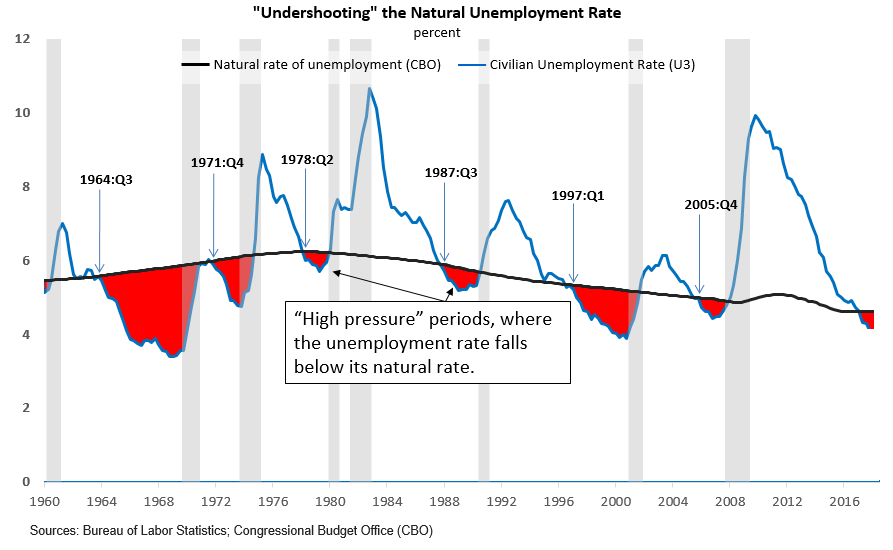Over the past few months, I have been asked one question regularly: Why is the Fed removing monetary policy stimulus when there is little sign that inflation has run amok and threatens to undermine economic growth? This is a good question, and it speaks to a philosophy of how to maintain the stability of both economic performance and prices, which I view as important for the effective implementation of monetary policy.
In assessing the degree to which the Fed is achieving the congressional mandate of price stability, the Federal Open Market Committee (FOMC) identified 2 percent inflation in consumption prices as a benchmark—see here for more details. Based on currently available data, it seems that inflation is running close to this benchmark.
The Fed's other mandate from Congress is to foster maximum employment. A key metric for performance relative to that mandate is the official unemployment rate. So, when some people ask why the FOMC is reducing monetary policy stimulus in the absence of clear inflationary pressure, what they really might be thinking is, "Why doesn't the Fed just conduct monetary policy to help the unemployment rate go as low as physically possible? Isn't this by definition the representation of maximum employment?"
While this is indeed one definition of full employment, I think this is a somewhat short-sighted perspective that doesn't ultimately serve the economy and American workers well. One important reason for being skeptical of this view is our nation's past experience with "high-pressure" economic periods. High-pressure periods are typically defined as periods in which the unemployment rate falls below the so-called natural rate—using an estimate of the natural rate, such as the one produced by the Congressional Budget Office (CBO).
As the CBO defines it, the natural rate is "the unemployment rate that arises from all sources other than fluctuations in demand associated with business cycles." These "other sources" include frictions like the time it takes people to find a job or frictions that result from a mismatch between the set of skills workers currently possess and the set of skills employers want to find.
When the actual unemployment rate declines substantially below the natural rate—highlighted as the red areas in the following chart—the economy has moved into a "high-pressure period."
For the purposes of this discussion, the important thing about high-pressure economies is that, virtually without exception, they are followed by a recession. Why? Well, as I described in a recent speech:
"One view is that it is because monetary policy tends to take on a much more 'muscular' stance—some might say too muscular—at the end of these high-pressure periods to combat rising nominal pressures.
"The other alternative is that the economy destabilizes when it pushes beyond its natural potential. These high-pressure periods lead to a buildup of competitive excesses, misdirected investment, and an inefficient allocation of societal resources. A recession naturally results and is needed to undo all the inefficiencies that have built up during the high-pressure period.
"Yet, some people suggest that deliberately running these high-pressure periods can improve outcomes for workers in communities who have been less attached to the labor market, such as minorities, those with lower incomes, and those living in rural communities. These workers have long had higher unemployment rates than other workers, and they are often the last to benefit from periods of extended economic growth.
"For example, the gap between the unemployment rates of minority and white workers narrows as recoveries endure. So, the argument goes, allowing the economy to run further and longer into these red areas on the chart provides a net benefit to these under-attached communities.
"But the key question isn't whether the high-pressure economy brings new people from disadvantaged groups into the labor market. Rather, the right question is whether these benefits are durable in the face of the recession that appears to inevitably follow.
"This question was explored in a research paper by Atlanta Fed economist Julie Hotchkiss and her research colleague Robert Moore. Unfortunately, they found that while workers in these aforementioned communities tend to experience greater benefits from these high-pressure periods, the pain and dislocation associated with the aftermath of the subsequent recession is just as significant, if not more so.
"Importantly, this research tells me we ought to guard against letting the economy slip too far into these high-pressure periods that ultimately impose heavy costs on many people across the economy. Facilitating a prolonged period of low—and sustainable—unemployment rates is a far more beneficial approach."
In short, I conclude that the pain inflicted from shifting from a high-pressure to a low-pressure economy is too great, and this tells me that it is important for the Fed to beware the potential for the economy overheating.
Formulating monetary policy would all be a lot easier, of course, if we were certain about the actual natural rate of unemployment. But we are not. The CBO has an estimate—currently 4.5 percent. The FOMC produces projections, and other forecasters produce estimates of what it thinks the unemployment rate would be over the longer run.
For my part, I estimate that the natural rate is closer to 4 percent, and given the current absence of accelerating inflationary pressures, we can't completely dismiss the possibility that the natural rate is even lower. Nonetheless, with the unemployment rate currently at 3.7 percent, it seems likely that we're at least at our full employment mandate.
So, what is this policymaker to do? Back to my speech:
"My thinking will be informed by the evolution of the incoming data and from what I'm able to glean from my business contacts. And while I wrestle with that choice, one thing seems clear: there is little reason to keep our foot on the gas pedal."




 By
By